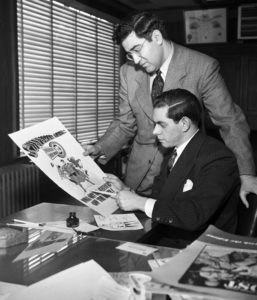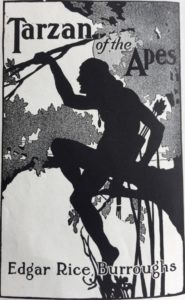Jerry Siegel and Joe Shuster
Jerry Siegel (1914–1996) and Joe Shuster (1914–1992), creators of Superman, one of a small
handful of fictional characters who are known around the world. It was while they were students at Cleveland’s Glenville High School in the mid-1930s that Siegel conceived,
and Shuster created the iconic image of, Superman; the story of his arrival as a baby from the doomed planet Krypton character; his alter ego & daytime persona Clark Kent; and the other characters and colorful villains who would captivate several generations.
Superman’s 1938 debut in Action Comics unleashed a flood of other superheroes (beginning with Batman) that has spawn a flood of comics, TV and radio series, blockbuster films and graphic novels that continues to this day—as well as a series of books about the Man of Steel and his creators that began with the groundbreaking detective work of Cleveland writer Dennis Dooley that appeared in 1973 in Cleveland Magazine, “The Man of Tomorrow and the Boys of Yesterday.”
Though the character of Superman was inspired at least in part, as Dooley convincingly showed with evidence he discovered in the yellowing back issues of The Glenville Torch, by Tarzan of the Apes*, The Scarlet Pimpernel and the 1920 silent film The Mark of Zorro featuring a caped Douglas Fairbanks leaping from balconies, Siegel opened up decades of fresh possibilities by reversing the pattern set by those dashing predecessors: While Zorro and the Pimpernel were noblemen who led their real lives by day, donning costumes (and, significantly, masks) to pursue their nocturnal adventures as fictional personages, in Siegel’s creation Clark Kent, the daytime figure everybody (thought they) knew, would be the fiction, the man in the cape the actual person.
The exploits of Buck Rogers (which debuted in 1929) had been set in the 25th century. John Carter of Mars (1912), a man from the past (he’s a Civil War veteran), performed his astounding feats on another planet. The adventures of Superman would, by contrast, be set right here on earth—and in the present. (Indeed, Siegel and Shuster’s creation would initially be rejected on the grounds that “nobody would believe it.”) And it was inspired by Cleveland’s tall buildings, and at least two of its now world-famous characters, by Jerry’s companions at Glenville High School.

By Unknown author – New Yorker, Public Domain, https://commons.wikimedia.org

*A fresh discovery: Exploring the yellowing back issues of the Glenville High School Torch in
1973, Dooley turned up a hilarious parody of Tarzan (“Goober the Mighty”) authored by the teenage Jerry Siegel. But it was only recently, says Dooley, “having decided to sit down and actually read Edgar Rice Burroughs’ seminal 1914 novel because my son, a Chicago actor, had recently narrated audio books of eleven of the Tarzan books, that I made a startling discovery.
“Until now it’s been universally assumed that the Man of Steel’s iconic name owed its origins to Nietzsche’s Ubermensch, commonly translated as the ‘superior man’, or Shaw’s 1903 play Man and Superman, which plays with Nietzsche’s idea that a “will to power [in Modern Man] creates a desire for self-mastery.” But it now appears the young Siegel may well have been more directly inspired—by a brief passage near the end of Tarzan of the Apes in which Jane’s companion snidely refers to her dreamboat ‘forest man’ as ‘this super-man of yours.’”
Following tantalizing clues preserved for decades in the pages of the Torch, Dooley also identified, for the first time, the high school friends who’d inspired the characters of Clark Kent (shy, bespectacled Torch reporter Wilson Hirschfeld, who would one day become managing editor of the Plain Dealer) and Lois Lane (the Torch’s intrepid girl reporter Lois Amster—not, as some believe, Siegel’s eventual wife Joanne, who would become the visual model for Shuster’s drawings). Years later, Cleveland Public Radio’s David C. Barnett tracked her down for a memorable interview.
These originals were confirmed by former Torch staffers—including Jerome Lawrence Schwartz (another of our Past Masters), who had himself gone on to write such acclaimed plays as Inherit the Wind and Auntie Mame.
Siegel’s Jewish heritage also infused his creation. The baby Moses is found in a basket among the bull rushes; the baby Superman, in a tiny rocket ship in a field of corn. Like Moses and his descendants, Siegel’s cosmic wanderer has no home to return to, and must make a new life in a strange land, knowing he is different. Like the Hebrew prophets, he has a strong dedication to justice and the protection of the weak. Indeed, his iconic costume led Carroll political science professor Patrick Egan to describe Superman as “a flag with a human face.” Jerry Siegel’s creation would in fact embody America’s greatest challenge: Finding himself possessed of unimagined power, he is time and again blocked from using it by his unwillingness to endanger the innocent or harm the planet.
“In all the history of literature,” said Harlan Ellison, “there are only five fictional creations known to every man, woman and child on the planet. The urchin in Irkutsk may never have heard of Hamlet, the peon in Irkutsk may never have heard of Hamlet, the peon in Pernambuco may not know who Raskolnikov is; the widow in Jakarta may stare blankly at the mention of Don Quixote or Micawber or Jay Gatsby. But every man, woman and child on the planet knows Mickey Mouse, Sherlock Holmes, Tarzan, Robin Hood . . . and Superman.
“He is more than the fanciful daydream of two Cleveland schoolboys. He is the 20th century archetype of mankind at its finest. He is courage and humanity, steadfastness and decency, responsibility and ethic. He is our universal longing for perfection, for wisdom and power used in the service of the human race. Of all the literary creations of American fiction, Superman, after all these years, born of a ‘dispensable, disreputable’ genre, is the only one that seems to get Posterity’s nod. And that is because, simply put, he is our highest aspirations in human form.’”—Superman at Fifty: The Persistence of a Legend (Octavia Press, 1987)
Another locally-based authority, who is available for interviews, is Brad Ricca, the author of Super Boys: The Amazing Adventures of Jerry Siegel and Joe Shuster—the Creators of Superman (2014), who lives in Cleveland Heights.